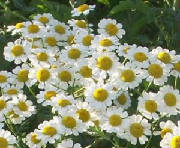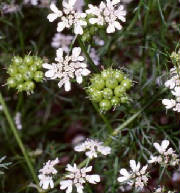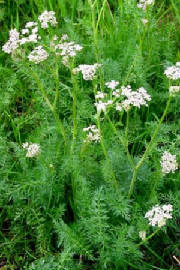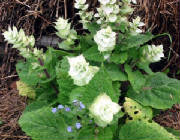|

Chamomile
A
perennial, a native of England, cultivated for its flowers, which have a bitter, aromatic taste, and are in small doses a
useful tonic, but given largely, act as an emetic. An infusion of them improved digestion and
gives tone to the disordered stomach. The flowers are sometimes chewed as a substitute for tobacco.
|
 |

Caraway
Caraway is cultivated for its seeds, which are used in confectionery; as in cakes, comfits, &c., and the leaves
are sometimes used in soups. The roots are said to excel those of the parsnip, being formerly cooked and used in the
same manner. Medicinally the seeds are used in an infusion for flatulence.
|
 |
 |
|

Coriander
Some like its tender leaves for soups and salads, but it is raised mostly for its seeds which have a pleasant aromatic
taste, though the smell is disagreeable. Coriander seed is carminative and stomachic. It is often used to disguise
the taste of medicines, but it is principally employed in confectionery.
[Thomas Stuart
McFarland, a farmer near Belgrade, Newton County, in southeast Texas, reported that he had pennyroyal in his garden as April
16, 1840.]
|
|
 |
 |
 |
|

Clary
The leaves of this plant were formerly used in soups, and its flowers are now made use of in a fermented wine.
The medicinal virtues of the plant are cordial and astringent, and it is used either in its fresh or dried state.
|
|

